MARIANI’S
Virtual
Gourmet
October
22, 2017
NEWSLETTER

"Downton Abbey"
IN THIS ISSUE
CHECKING OUT THE CELEBRITY CHEFS:
GRANT ACHATZ'S ALINEA AND
DAVID CHANG'S MOMOFUKU KO
By John A. Curtas
NEW YORK CORNER
SALINAS
By John Mariani
NOTES FROM THE WINE CELLAR
A NEW RESPECT FOR MALBEC
AT CHÂTEAU LAGRÉZETTE
BY JOHN MARIANI
❖❖❖
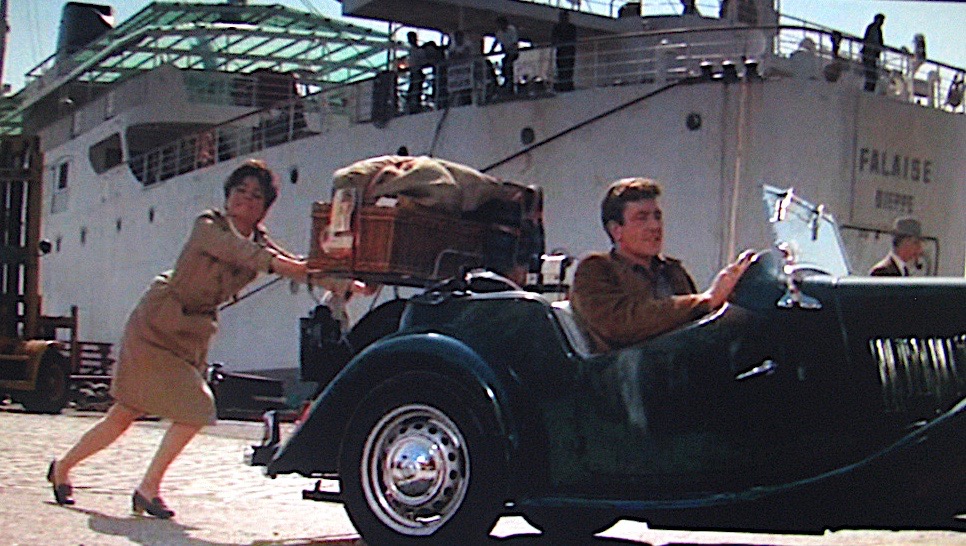
ANNOUNCEMENT! There will be no issue of Mariani's Virtual Gourmet next week (October 29) because Mariani will driving around Normandy and Brittany for his readers' edification.
❖❖❖
CHECKING OUT
THE CELEBRITY CHEFS:
GRANT ACHATZ'S ALINEA AND
DAVID CHANG'S MOMOFUKU KO
By John A.
Curtas
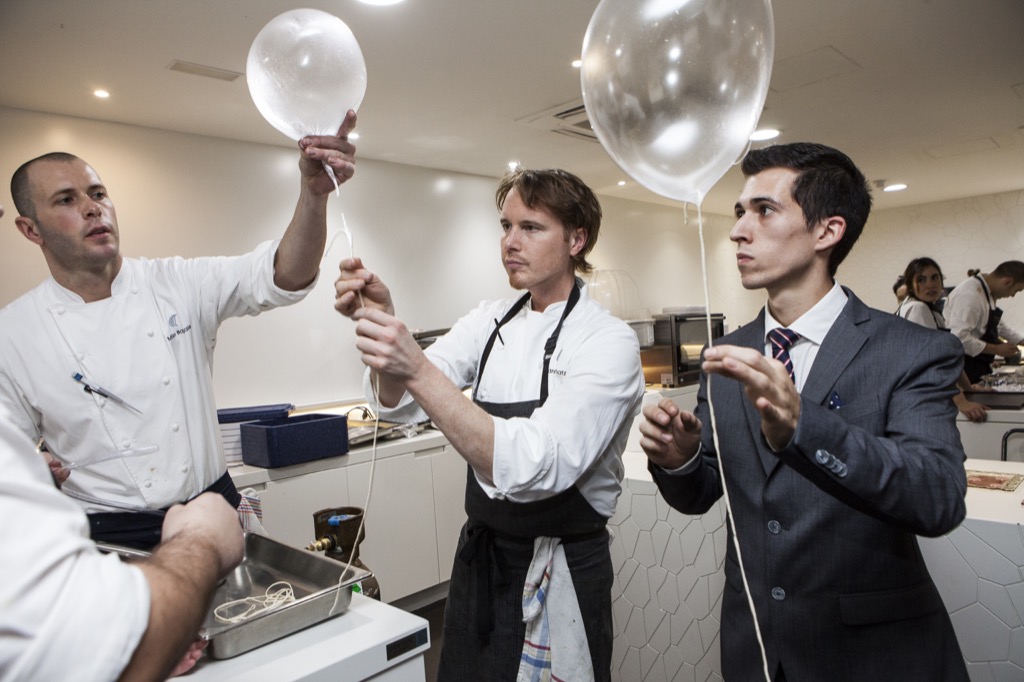
Grant Achatz (center)
at Alinea, Chicago
In
the past decade, restaurant going has become a
sport, and the prize is bragging rights. Like
Big Game hunting, it doesn't take much skill to
pursue this hobby, just money.
Most restaurant hunters focus
on the biggest game—the most exclusive, hard to
get to, hard to get into, restaurants on the
planet. The wholly obtuse “50 Best Restaurants” is
their Field
& Stream, and the salons of social media
are where the hides are hung. As with all
trophy seekers, innate pleasure is secondary to
tangible achievement. In this arena, there
is no such thing as the private, visceral
enjoyment of a sensual pleasure. If you didn't get
a picture of it, did it really happen?
 Once, only
the Michelin
Guide had that kind of clout; now it is the
fodder of the internet. But the rise of social
media, starting around 2009, when most grownups
discovered Facebook, and a phenomenon known as
FOMO (fear of missing out) fueled the current
mania. Once a well-heeled show-off learned that
there was social currency in being able to boast
about where and what you were eating, the game was
on. Suddenly, thousands of foodies around the
globe started putting restaurants on a pedestal
far out of proportion to what was actually
happening in them.
Once, only
the Michelin
Guide had that kind of clout; now it is the
fodder of the internet. But the rise of social
media, starting around 2009, when most grownups
discovered Facebook, and a phenomenon known as
FOMO (fear of missing out) fueled the current
mania. Once a well-heeled show-off learned that
there was social currency in being able to boast
about where and what you were eating, the game was
on. Suddenly, thousands of foodies around the
globe started putting restaurants on a pedestal
far out of proportion to what was actually
happening in them.
Chicago’s
Grant Achatz was perfectly situated to
capitalize on this phenomenon when he opened
Alinea (left)
in 2005, and his timing couldn't have been
better. Between the hagiographic
slobbering the media was doing over Ferran Adria’s
molecular cuisine in Spain and similar praise for
Thomas Keller for his endless tasting menus at
French Laundry and Per Se, it was time to turn up
their ideas by introducing to the Midwest the
glories of marathon meals composed of
unrecognizable food. 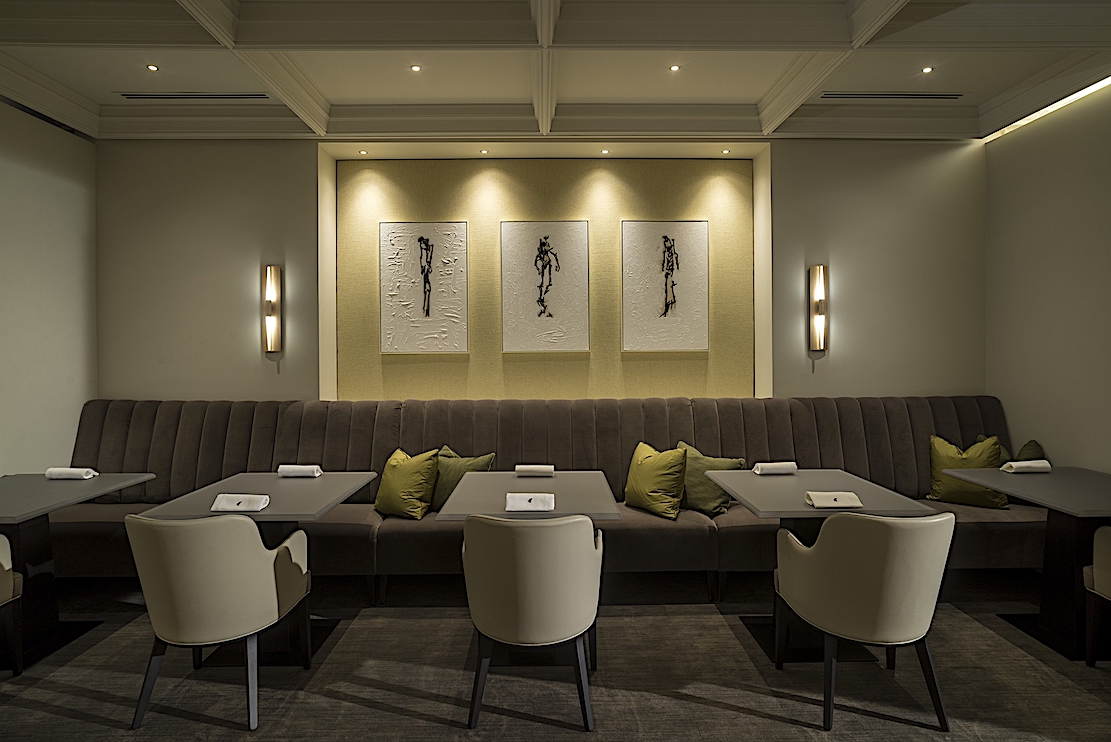
It was the height of the
economic boom—which
was about to go bust—and for several years
Achatz and his restaurant were the media darlings
of foodie America. The Chicago media treated
him like a saint no one dare criticize.
Alinea’s ten-year anniversary
called for a re-boot, so the restaurant now boasts
a downstairs main room and an upstairs salon with
a slightly shorter menu. Dinner is now more like
fifteen courses than twenty-five, though it's
still a three-and-a-half-hour slog, and the price
is still a hefty car payment, exclusive of tax or
tip. There is no bar. Indeed, there is barely a
storefront (above),
only an address on a building.
My meal at Alinea 2.0 began
with Achatz’s signature black truffle "oreo” (below)—a dish
that is supposed to dazzle with its ability to
intensify and combine the flavors of two iconic
ingredients, Parmesan cheese and truffles, but for
me managed to taste of neither. It looks like one
thing and tastes like something else. And that's
about all it tastes like, thus setting the tone
for most of your meal.
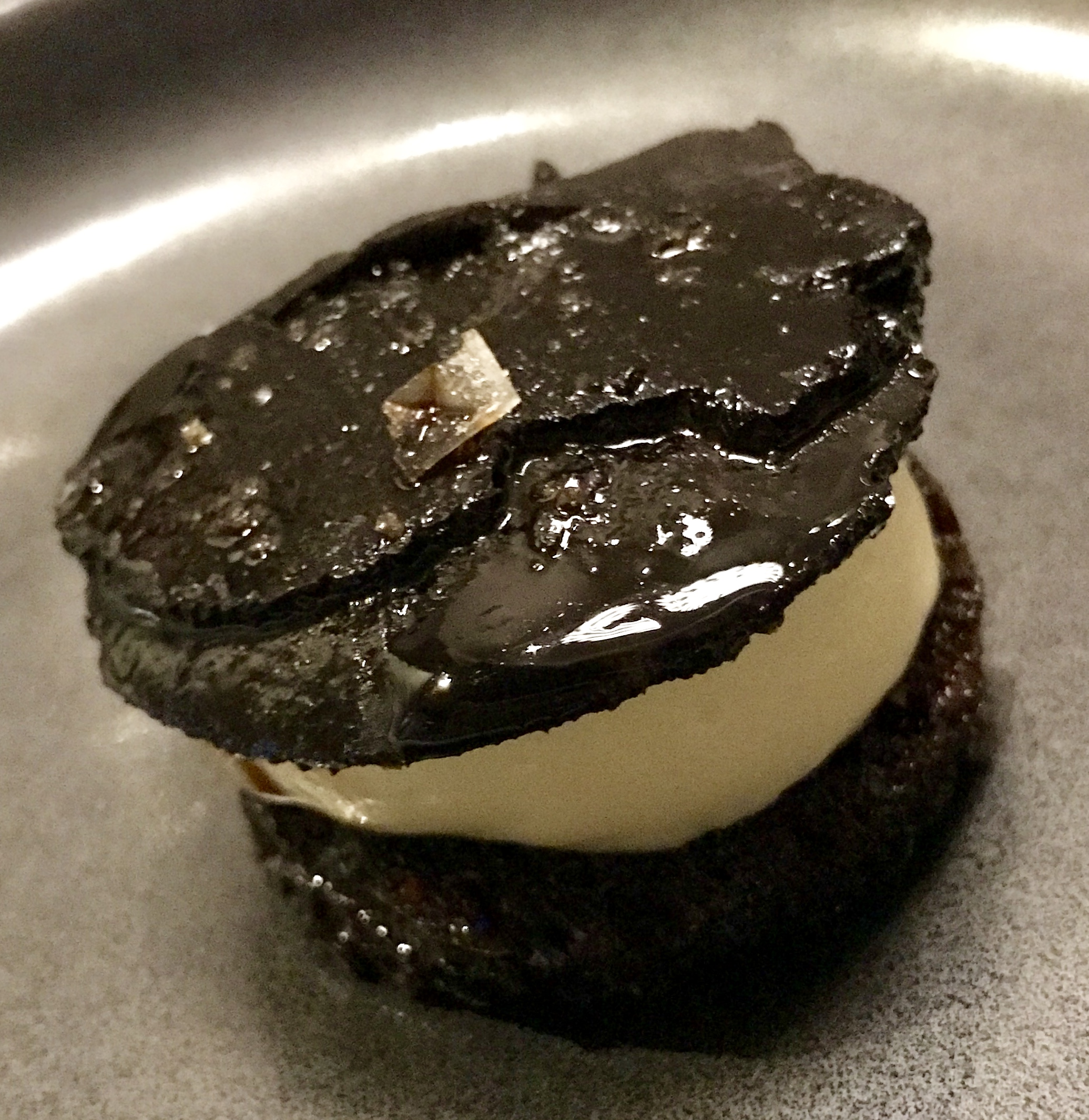 There
are all sorts of gee-gaws (19th century cocktail
shakers, candy bar balloons, molecular disguises)
put in place to elicit oohs and ahs, but what is
missing is flavor—the taste of things as they are
supposed to be, not what they've been manipulated
into. Thus, a spear of rhubarb with avocado and
coriander barely hints at any of those; continue
directly to a "Pea, Parmesan, Meyer Lemon
Swirl/Apple Lemon Balm Yuzu" that was an odd soup,
attended to by a mass of acid with some powdered
something beside it. (Do people still think
reducing food to dust is über-cool? In Chicago,
apparently yes.)
There
are all sorts of gee-gaws (19th century cocktail
shakers, candy bar balloons, molecular disguises)
put in place to elicit oohs and ahs, but what is
missing is flavor—the taste of things as they are
supposed to be, not what they've been manipulated
into. Thus, a spear of rhubarb with avocado and
coriander barely hints at any of those; continue
directly to a "Pea, Parmesan, Meyer Lemon
Swirl/Apple Lemon Balm Yuzu" that was an odd soup,
attended to by a mass of acid with some powdered
something beside it. (Do people still think
reducing food to dust is über-cool? In Chicago,
apparently yes.) 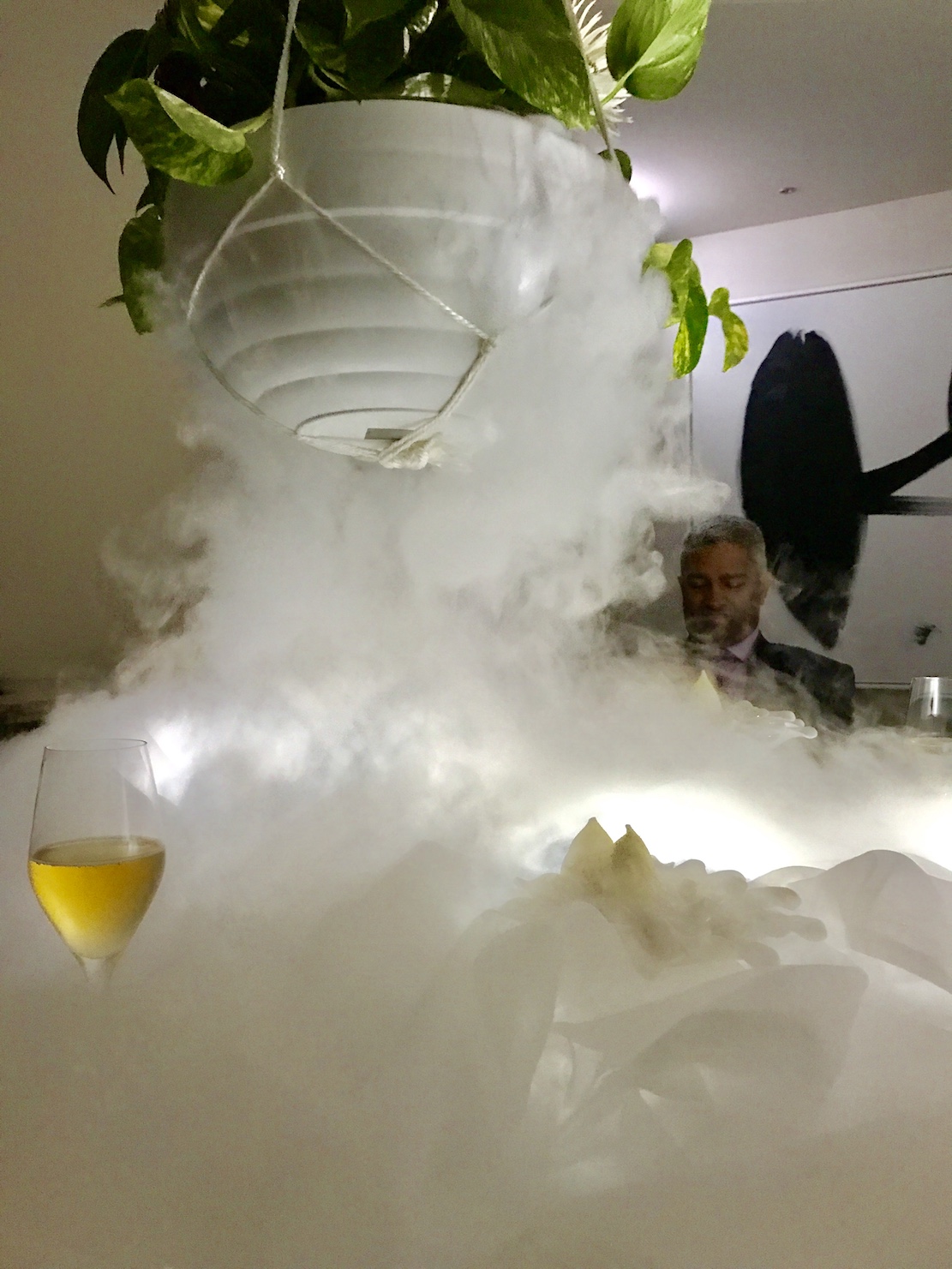
To Achatz’s credit, his Thai
coconut with black bass actually tasted of those
ingredients, but I'm still trying to figure out
what was going on with a barely there “Rouille
Nori Paper” in a small bowl of olive oil-slicked
broth. The words "langoustine" and "Bouillabaisse"
appeared in the title but never arrived on the
palate. Likewise, a pork belly with curry mango
could've come from anywhere, and (to keep the
clichés coming) the short rib was loaded with
smoke. As with most of the menu, the advertised
flavors (e.g.,
hamachi, blueberry, lapsang
souchong, morel steam, rosemary, kombu)
never rang out, perhaps because there were so many
of them per dish that they canceled each other
out.
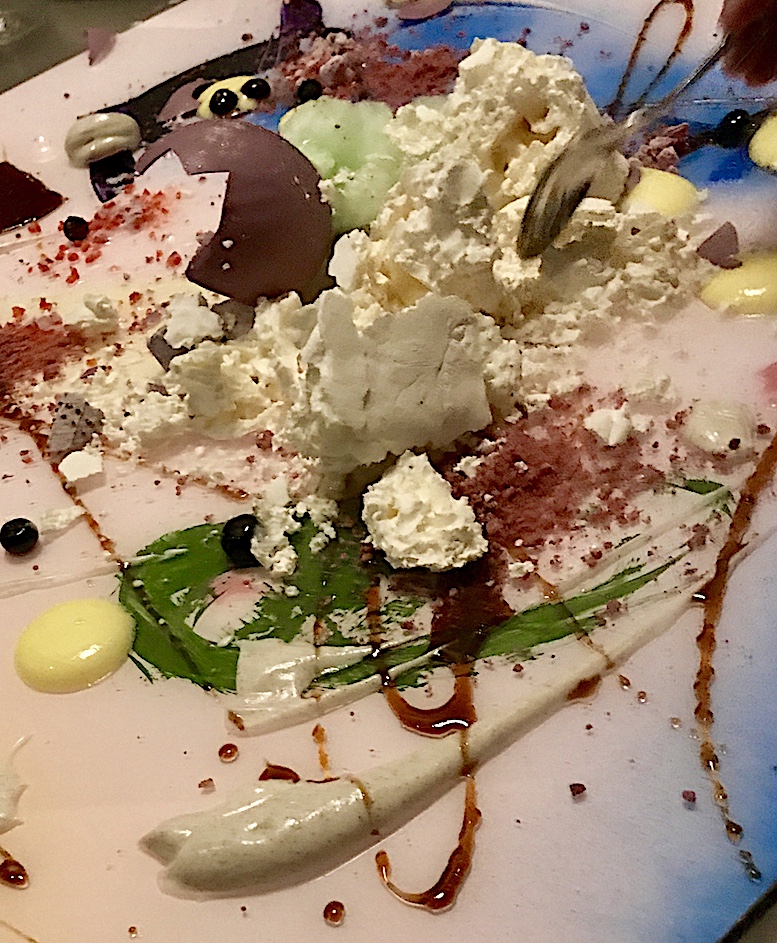 Whether you like the Impressionist
painting mess they call dessert here (left) pretty
much depends on your capacity to suspend your
disbelief in how something so convoluted could be
so much less than the sum of its parts.
Whether you like the Impressionist
painting mess they call dessert here (left) pretty
much depends on your capacity to suspend your
disbelief in how something so convoluted could be
so much less than the sum of its parts.
Alinea surely had its place in
bringing such consumable convolution to the
Midwest a decade ago, but these days it's little
more than chefs doing cartwheels in the kitchen
and pirouettes on the plate, and not very well at
that. Respect for ingredients isn't the
watchword here—the ability to manipulate them is
all that matters. Did Achatz lose his palate
or did this restaurant lose its mojo?
Belt-notching gastronomads don't care, but anyone
with all their taste buds ought to.
Life is too short to be
confused by your food.
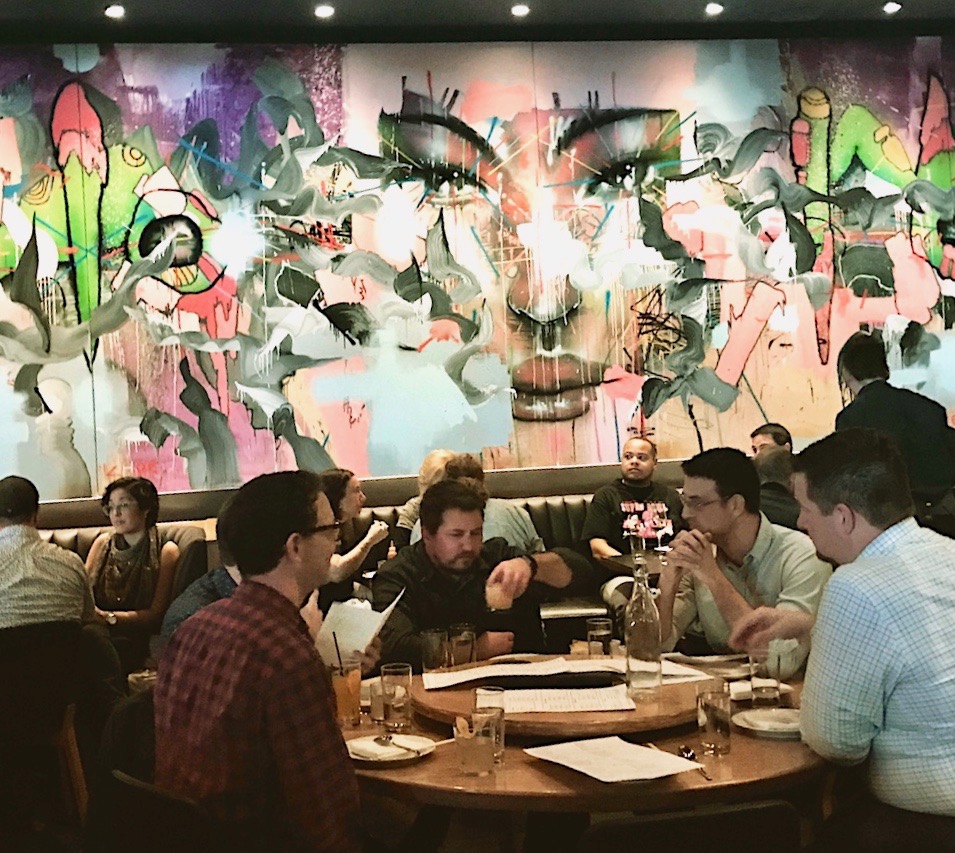 It’s
hard not to admire what Chef David Chang has
done with Momofuku (“Lucky Peach” in
Korean). What began as an eight-seat eatery in
lower Manhattan in 2004 has spawned an empire that
now stretches from Soho, New York, to Sydney,
Australia. It’s
also not hard, after eating your way through
Momofuku, to sometimes wonder what all the
shouting is about—shouting from the rooftops being
what the influential New York food media has done
almost from the day Chang opened. Once they laid
the groundwork, social media took over, and for
well over a decade foodies the world over have
been inundated with tales of Chang’s influence and
ground-breaking cuisine.
It’s
hard not to admire what Chef David Chang has
done with Momofuku (“Lucky Peach” in
Korean). What began as an eight-seat eatery in
lower Manhattan in 2004 has spawned an empire that
now stretches from Soho, New York, to Sydney,
Australia. It’s
also not hard, after eating your way through
Momofuku, to sometimes wonder what all the
shouting is about—shouting from the rooftops being
what the influential New York food media has done
almost from the day Chang opened. Once they laid
the groundwork, social media took over, and for
well over a decade foodies the world over have
been inundated with tales of Chang’s influence and
ground-breaking cuisine.
When other chefs and
restaurants went into recession hibernation in
2008, Chang (right)
kicked his expansion into high gear, opening
noodle bars, 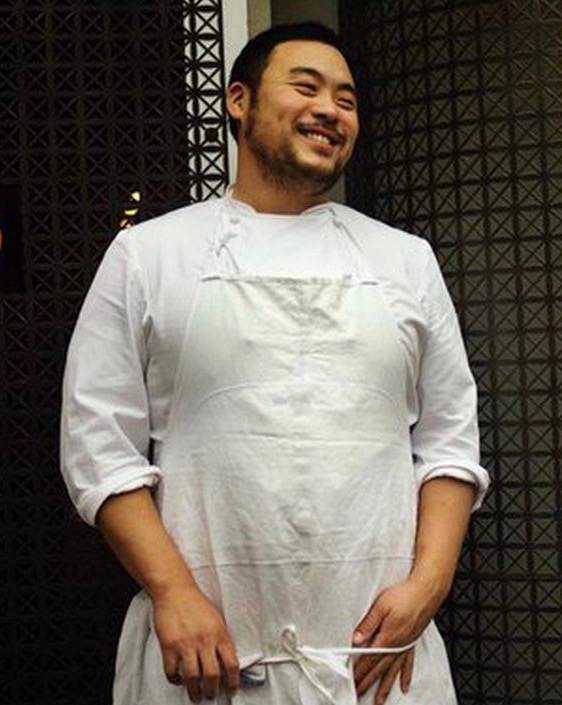 Vietnamese restaurants
and impossible-to-get-into joints in NYC,
expanding his brand while taking full advantage of
the rise of the Millennials and their need to have
something tasty (and Instagram-worthy) to eat.
There are now five Momofukus in the world, more
are planned, and to the delight of his fans, Las
Vegas finally has one.
Vietnamese restaurants
and impossible-to-get-into joints in NYC,
expanding his brand while taking full advantage of
the rise of the Millennials and their need to have
something tasty (and Instagram-worthy) to eat.
There are now five Momofukus in the world, more
are planned, and to the delight of his fans, Las
Vegas finally has one.
In the beginning, the entire Chang oeuvre
consisted of barely a handful of items. Because of
its small size, the original Momofuku Noodle Bar
in lower Manhattan featured a few bowls of ramen,
a couple of appetizers and some stuffed bao buns and
that was it. On such bare bones was a food empire
born.
The genius of what Chang did
was in upgrading those noodles, enriching the
broth, and loading smoky bacon onto classic Korean
and Japanese items that, until he came along, most
Americans wouldn’t touch with a ten-foot
chopstick. He
also cooked and seasoned the Korean fried chicken
like a real chef and made a big deal about using
better ingredients. No bottom bin ham for him. He
used real Virginia country ham, Kurobuta pork, and
the fluffiest bao
he could find. He cured his own pickles too (a big
deal in 2004) and made sure everyone in the food
media knew about it.
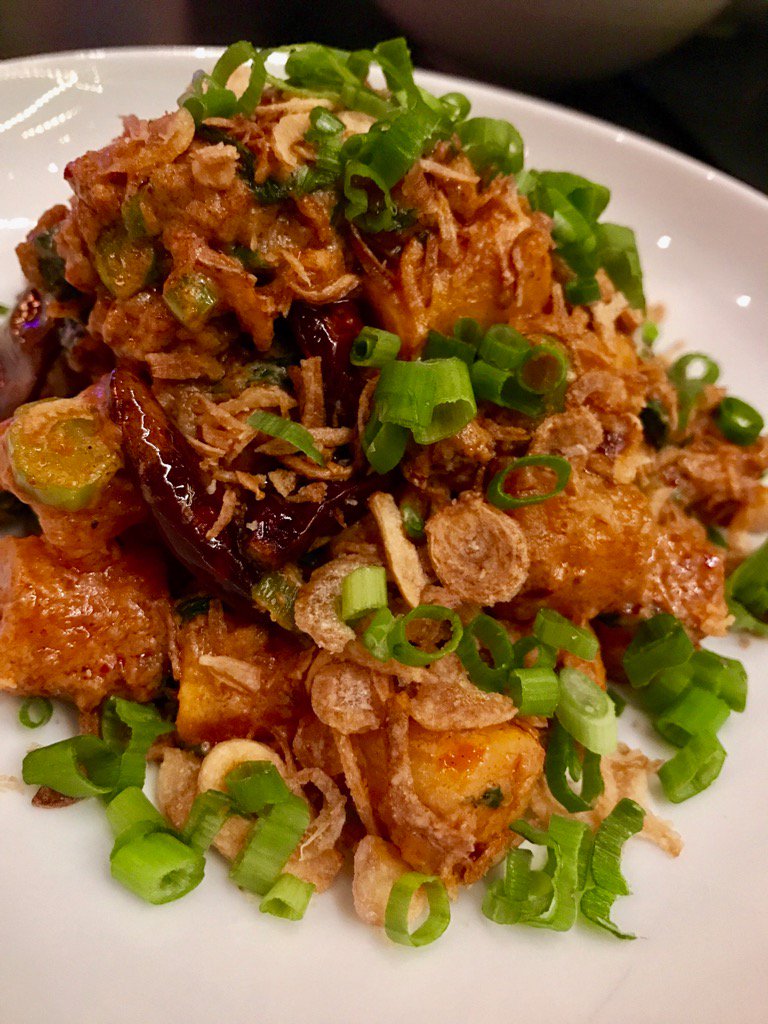 Most
of all, though, Momofuku became all about
umami—the word for the intense, savory quality
that only the densest, saltiest, most amino-acid
rich foods (like steak, cheese, smoked meats and
soy sauce) possess.
In the Chang universe (then and now), it’s
all about overwhelming your palate with this fifth taste
(after sweet, sour, salty, and bitter). His food
does this at the expense of delicacy and
refinement, but his audience doesn’t seem to care
one bit—subtlety being as important to a David
Chang meal as dialogue is in a Vin Diesel movie.
Thus will most of your meal be so umami-drenched
that your palate will be screaming for mercy after
several plates, each overloaded with whatever
miso-shoyu-smoky-kombu concoction Chang can’t help
incorporating into every bite.
Most
of all, though, Momofuku became all about
umami—the word for the intense, savory quality
that only the densest, saltiest, most amino-acid
rich foods (like steak, cheese, smoked meats and
soy sauce) possess.
In the Chang universe (then and now), it’s
all about overwhelming your palate with this fifth taste
(after sweet, sour, salty, and bitter). His food
does this at the expense of delicacy and
refinement, but his audience doesn’t seem to care
one bit—subtlety being as important to a David
Chang meal as dialogue is in a Vin Diesel movie.
Thus will most of your meal be so umami-drenched
that your palate will be screaming for mercy after
several plates, each overloaded with whatever
miso-shoyu-smoky-kombu concoction Chang can’t help
incorporating into every bite. 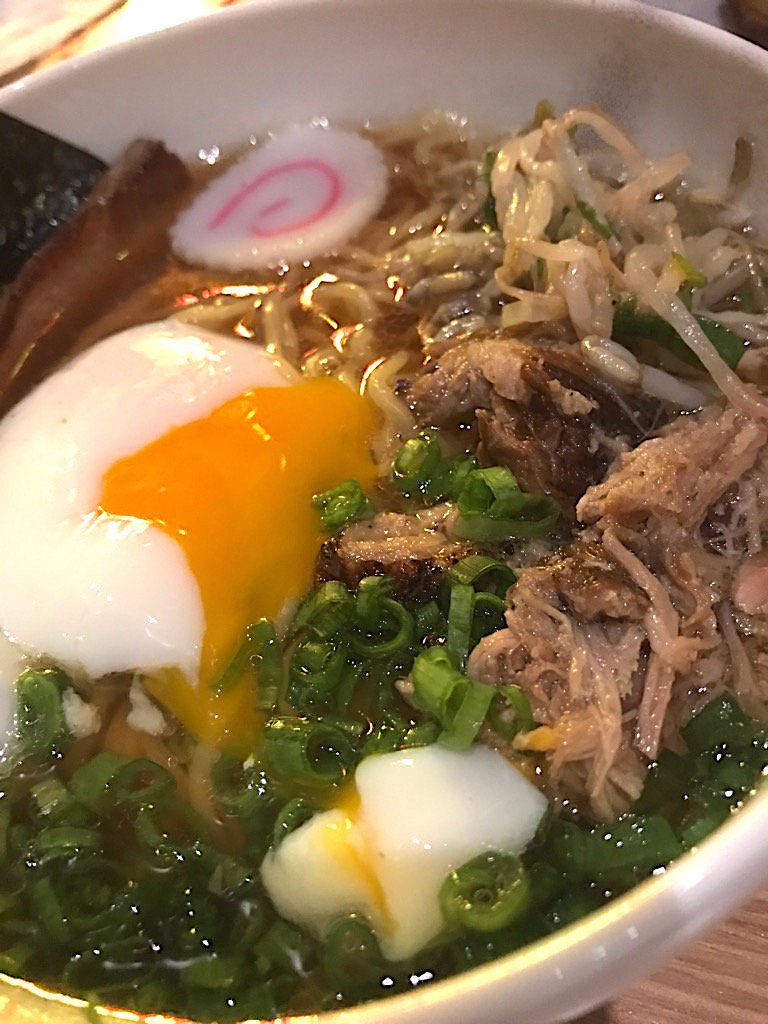
If smoke is your thing, you’ll
be in smoked hog heaven. By all means then, don’t
miss the pork meatballs swimming in (you guessed
it) plenty of smoked black-eyed peas. Is
Momofuku’s pork ramen soup good? Yes, but it’s
also so smoky that three sips in you will want to
run up the white flag. Ditto the oysters Momofuku,
whose seafood essence is obliterated by smoky
bacon bits. There’s also a smoked pork chop and
roasted mussels on the menu, with the mussels
being festooned with (wait for it) plenty of
smoked Benton’s bacon! The food is so smoky it
ought to be sponsored by Marlboro.
When Chang and his troops are
through pouring on the smoke, they find many other
ways to up the umami ante. Sichuan rice cakes are
thick stubby rice noodles smothered with pork
sausage, while chilled spicy noodles get a heap of
sausages and cashews to effectively overwhelm the
interesting starches and spices beneath them—pork
sausage and cashews being the belt and suspenders
of the umami-overload universe.
After three trips around this
menu, I threw in the towel. There are some good
things to eat here—the spicy cod hotpot using
quality fish, well-treated; the katsu chicken with
an old-fashioned mushroom cream sauce—but by the
time you get to them, you will have been drowned
by a tsunami of umami.
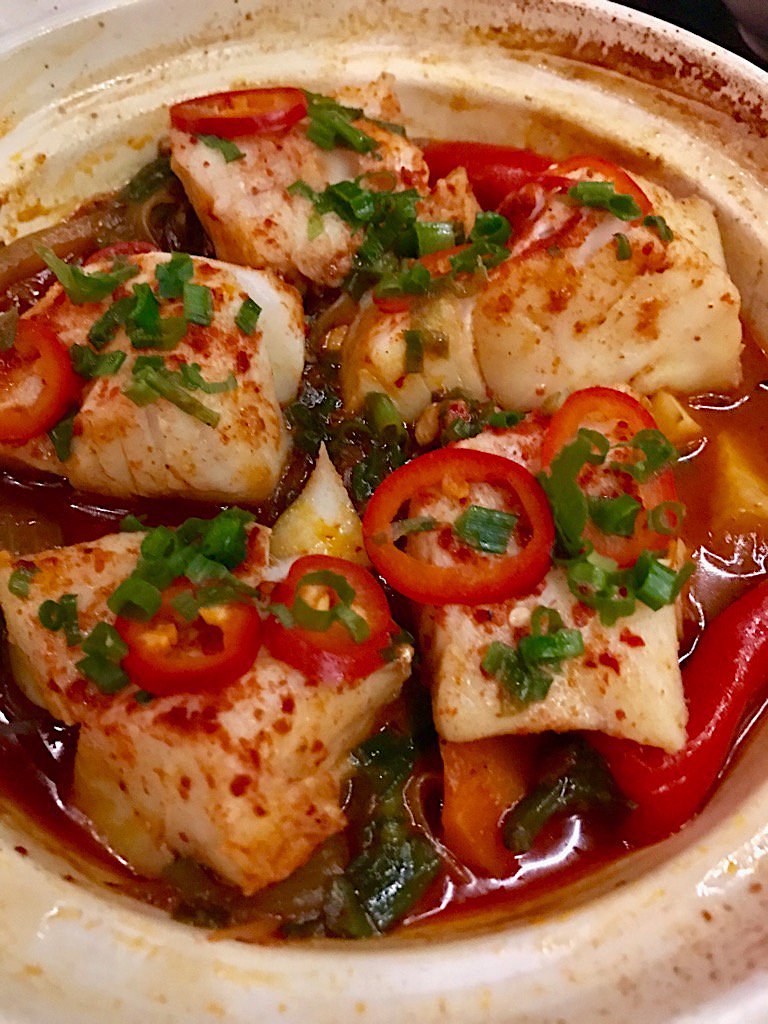 By all
means get the pork belly buns (the ones that made
Chang famous), but skip the chicken karaage
version, which is sadly stringy. The vaunted
rotisserie chicken comes with deep-fried bones
(some edible, some not), and is not as good as it
sounds.
By all
means get the pork belly buns (the ones that made
Chang famous), but skip the chicken karaage
version, which is sadly stringy. The vaunted
rotisserie chicken comes with deep-fried bones
(some edible, some not), and is not as good as it
sounds.
What is good
is the seating. You may have trouble getting one,
but that’s only because every under-40 in Vegas
seems to be beating a path to this second floor
location in The Cosmopolitan these days. What they
find is a large restaurant fronted by a long bar
that itself is five times the length of the
original operation. Beside that bar are a number
of high top tables for waiting, drinking or
overflow dining, and beyond them a huge open
kitchen that looks like it could feed an army
base. For its size, the room is remarkably
comfortable, the tables well spaced, and the 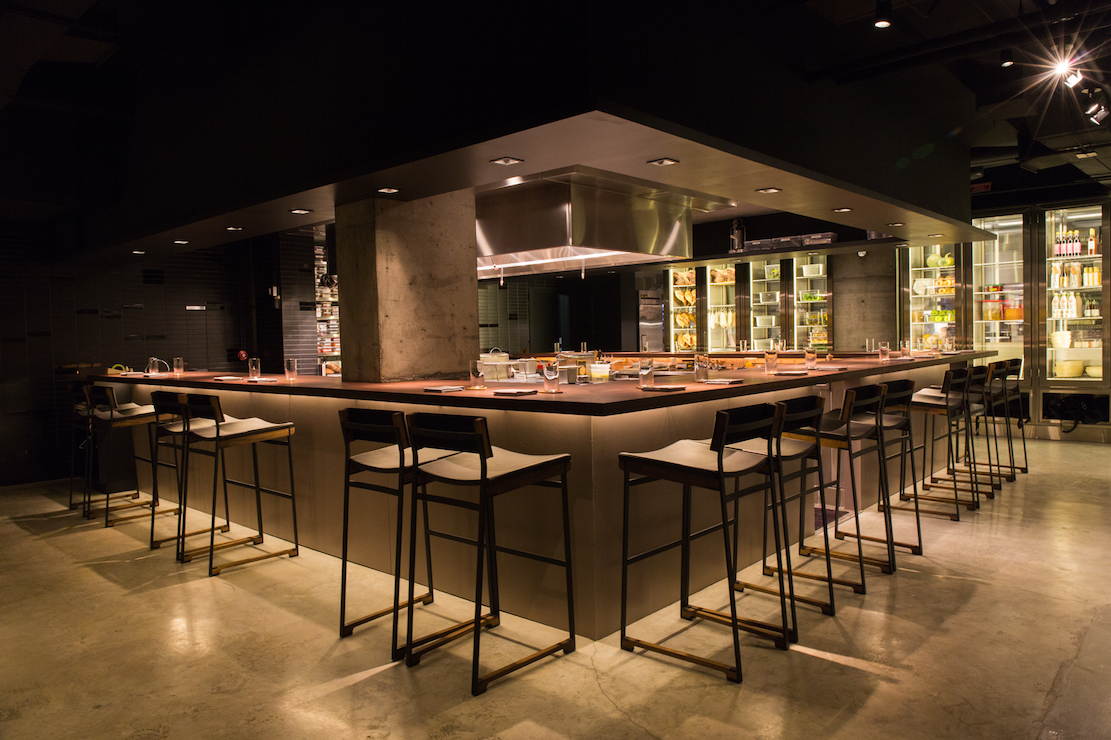 noise level relatively
civilized. Service is also top notch, with
management and waiters who are well versed in the
food.
noise level relatively
civilized. Service is also top notch, with
management and waiters who are well versed in the
food.
The wine list is sinfully overpriced, and
the sake/sochu list woefully sparse.
David Chang deserves a lot of
credit. He made this food safe for aspirational
foodies and non-Asians alike—folks with limited
resources who wanted to hop on the foodie
bandwagon and expand their knowledge of chewy
noodles, miso broth and various edible esoterica.
All of this was a treat when you were ducking into
a teeny tiny noodle emporium for a quick fix of
soup and a bao
bun. To put an entire meal together from
this food, however, after your taste buds have
been bludgeoned into one-dimensional submission, is a
big-box experience of a different order. If you
still use “party” as a verb, and don’t mind that
everything on your table tastes the same, you
might feel right at home amongst all the umami.
Nothing about Momofuku is as good as its
reputation, but in this day and age, that’s
enough.
By John Mariani
SALINAS
136 Ninth Avenue (near 18th Street)
212-776-1990
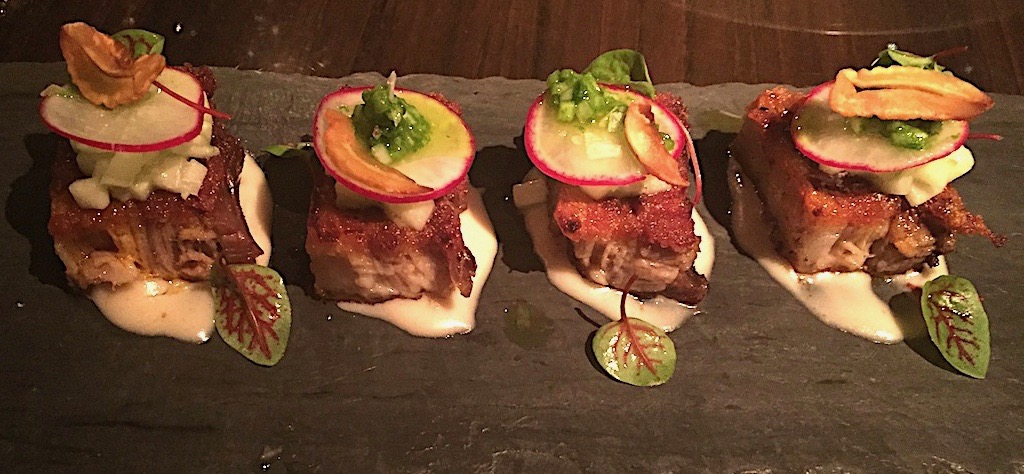
Since
cutting back a bit on my out-of- town travel and
my impulse to check
out
every new restaurant in NYC, I’ve been able on
occasion to go
back
to favorite places I’d almost forgotten about,
like Salinas, which seven
years
ago I put on my list of Best New Restaurants in
America. So when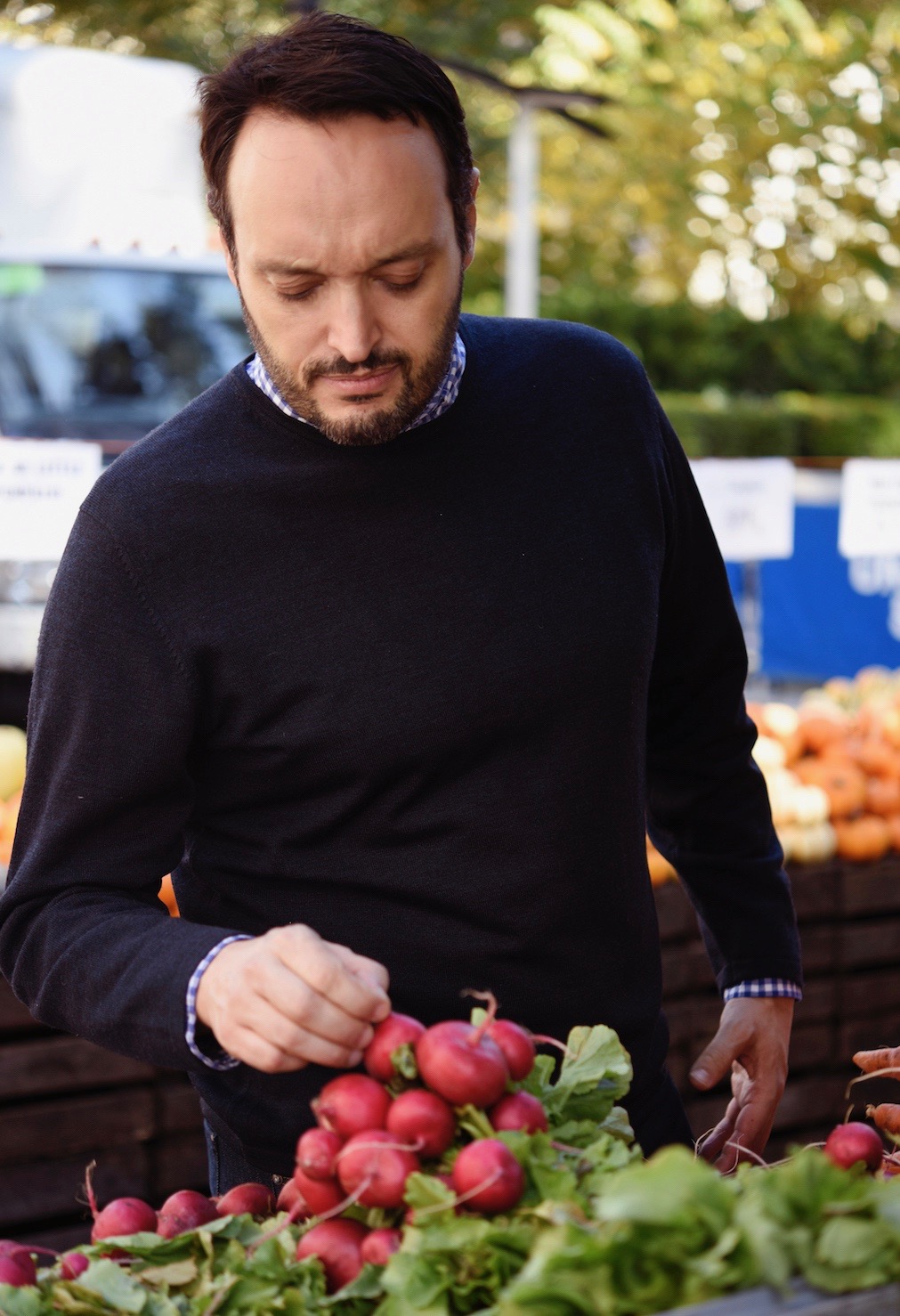 an opportunity to dine
with a German hotelier came along, I thought he’d
enjoy something
as
unusual and imaginative as this colorful modern
Spanish
restaurant
on Ninth Avenue and 18th Street.
an opportunity to dine
with a German hotelier came along, I thought he’d
enjoy something
as
unusual and imaginative as this colorful modern
Spanish
restaurant
on Ninth Avenue and 18th Street.
I said modern, not
modernist, for while owner Luis Bollo is one of
the most highly creative Spanish chefs
around, he has never gone over the edge of concocting molecular fantasy food
in the tradition of Ferran Adrià and his acolytes. Bollo knows all those
tricks but uses only his more traditional culinary skills to create dishes
where everything is quite beautiful, sometimes complex but always tasting
of the primary ingredient on the plate.
For instance: I do not like
fishy seafood, too often the result of an ingredient not of the best or
freshest quality. But Bollo knows how to treat
seafood which of its very nature has
a strong flavor, so, in the case of his dish of fresh white anchovies, he
marinates the little slivers of fish in cava
sparkling wine, whose acid, he said,
cuts the fishiness. He then serves it on crunchy multi-grain toast with
pomegranate caviar, and a sweet Bell pepper
vinaigrette ($12). The result is as
fascinating as it is delicious. Anyone who
has ever eschewed anchovies should
taste this dish (right).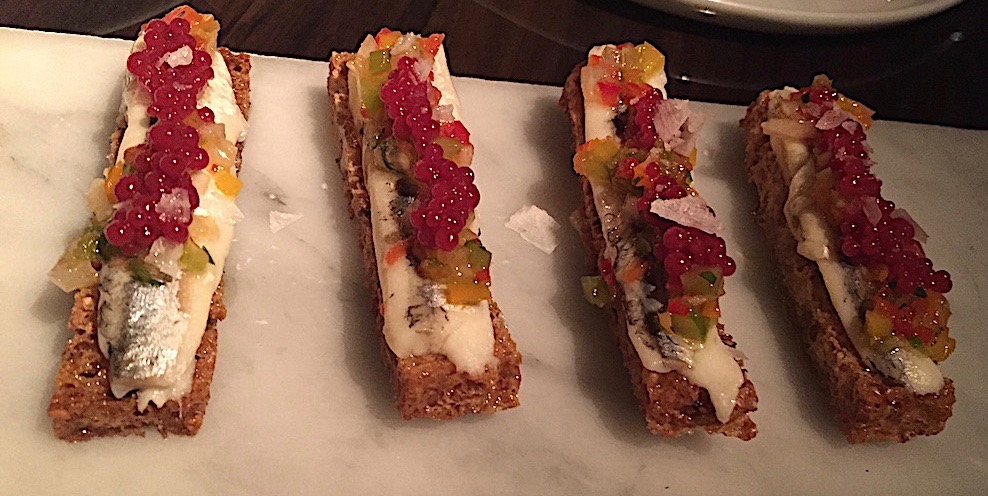
Pulpo tinta ($19) is a Galician octopus crusted with popcorn, fried in flax seed oil and tossed in a dark squid ink aïoli spiked with preserved lemon. Every flavor note hits on its own while enhancing the brininess of the octopus. Similarly, puntillas al yogurt ($16) is a dish of crispy baby calamari, roasted coriander-citrus yogurt, pickled purple pear onions and the pepper condiment called pimentòn de la Vera.
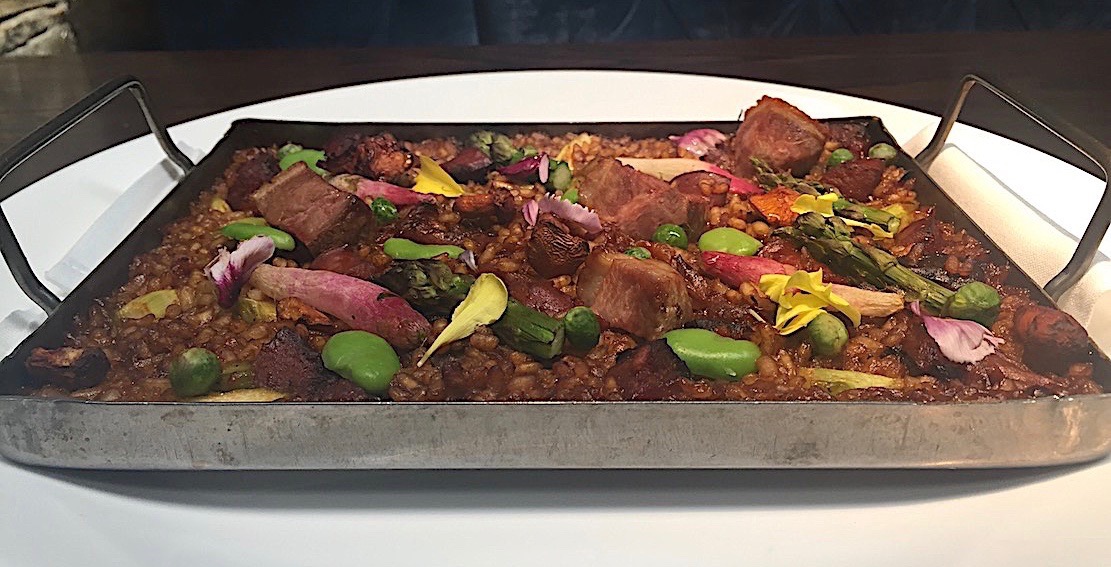 One
of the most wonderful dishes at Salinas is the coca de morcilla y hongos
($17), a flatbread from Balear, made with
rice-studded blood sausage, lobster mushrooms and sweet PX
Sherry made into an onion marmalade. Black Catalan rice, arroz negro, is
cooked a la plancha till crispy, as it is at the bottom of a
paella pot, with grilled red black Catalan rice and grilled local calamari,
Marcona almond ajoblanco
and a dill gelée ($23). Nothing modernist about it but
admirably modern and typical of Bolo’s ingenuity.
One
of the most wonderful dishes at Salinas is the coca de morcilla y hongos
($17), a flatbread from Balear, made with
rice-studded blood sausage, lobster mushrooms and sweet PX
Sherry made into an onion marmalade. Black Catalan rice, arroz negro, is
cooked a la plancha till crispy, as it is at the bottom of a
paella pot, with grilled red black Catalan rice and grilled local calamari,
Marcona almond ajoblanco
and a dill gelée ($23). Nothing modernist about it but
admirably modern and typical of Bolo’s ingenuity. Next came a plate of meloso de carabineros, Spanish red prawns with bomba rice, Manila clams and chanterelles in a light, saline shrimp reduced broth ($43). Juana de pato ($34) is a duck dish (left) enriched with foie gras and fragrant arborio rice, seasonal mushrooms and baby roots suffused with an octopus-duck broth.
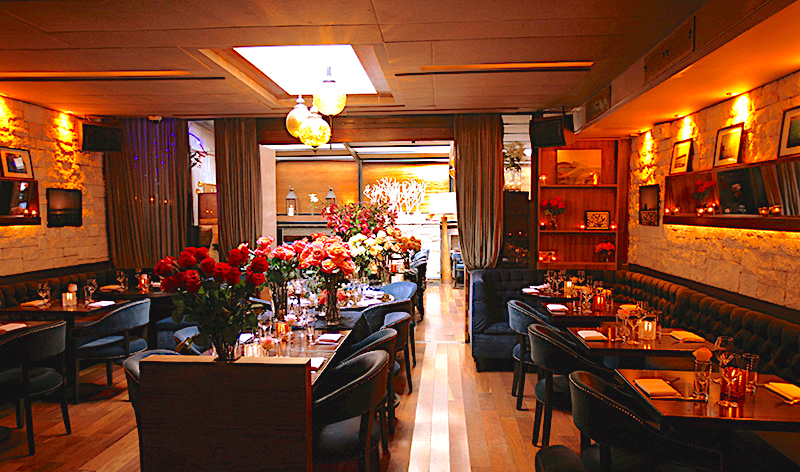
At this point we cried “Tío!”—knowing dessert would follow: a dark, flourless chocolate-pistachio tartin with salty pistachio brittle, Sicilian pistachio ice cream and a little olive oil ($12) . Also, migas andaluzas ($12), a mélange of Seville olive oil cookie crumbs, crispy cocoa-flavored meringue, Marcona almond praline, double chocolate ice cream and an accent of gold sea salt. One could hardly have a Spanish dinner without custard; Bollo calls his “Flan 2.0” ($13), which involves a foamy vanilla emulsion, dried mandarins and caramel bubbles—not really molecular, just playful for dessert.
The wine list is not all that long but it represents many of the finest Spanish bottlings now coming into this country, all at reasonable prices. The two dining rooms are warm and the service staff very cordial in every respect.
Spanish cuisine of this depth and breadth would be rare even in Barcelona, and in coming to America Luis Bollo gave us his great imagination and his hard work to produce something never seen before. That’s what immigrants so often do.
❖❖❖
AT CHÂTEAU LAGRÉZETTE
BY JOHN MARIANI
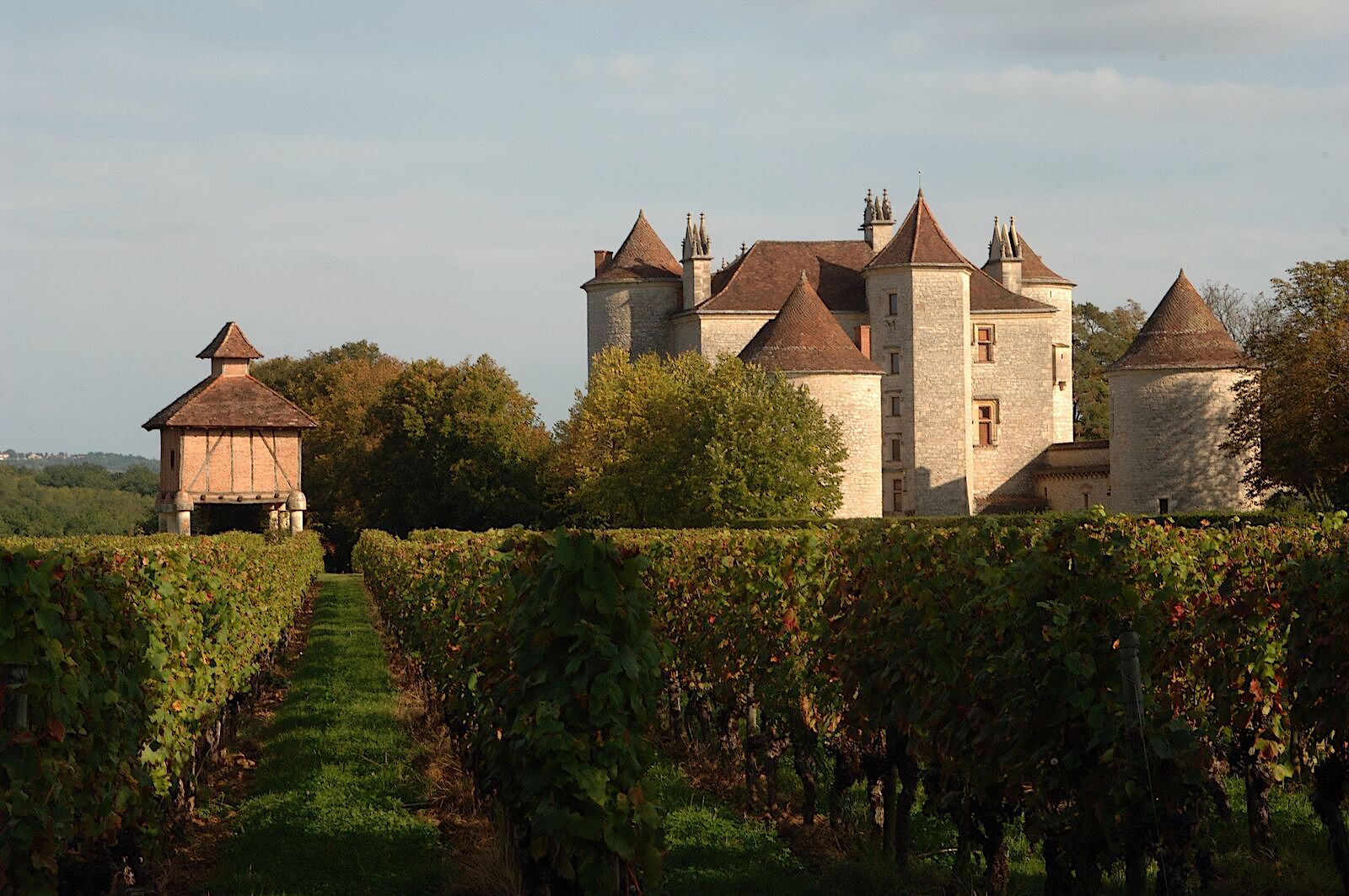
Malbec is certainly
not an unfamiliar grape—it’s usually third or
fourth down the list of varietals in a
Bordeaux blend—but, even more than with
Merlot, it’s not one to leap to mind when most
wine drinkers pick a bottle from a restaurant
list or shop shelf.
 To be
sure, Malbec (also known as Cot or Pessac) is
that soaring star of vineyards in Argentina, but
in France its flame glows brightly only in the
Bordeaux region of Cahors (left),
where, given the grape’s density and dark fruit,
it has long been known as “the black wine of
Cahors.” Elsewhere, plantings of Malbec are down
from 20th century levels; indeed plantings in
Cahors itself have dwindled.
To be
sure, Malbec (also known as Cot or Pessac) is
that soaring star of vineyards in Argentina, but
in France its flame glows brightly only in the
Bordeaux region of Cahors (left),
where, given the grape’s density and dark fruit,
it has long been known as “the black wine of
Cahors.” Elsewhere, plantings of Malbec are down
from 20th century levels; indeed plantings in
Cahors itself have dwindled.
The Cahors vineyards had been
wiped out by phylloxera in the late 19th
century, and to this day the vines struggle, for
the soil they grow in is largely composed of
sand and limestone, and local producers argue
over the best way to make a wine from Malbec,
sometimes mixing in Tannat and Merlot. Only a
handful of producers—Château du Cedre, Maison
Cosse Maisoneuve and Château Lagrézette—have
really put money and muscle behind the varietal
and the results have been impressive.
Which is why I was delighted
to find that an old friend, Claude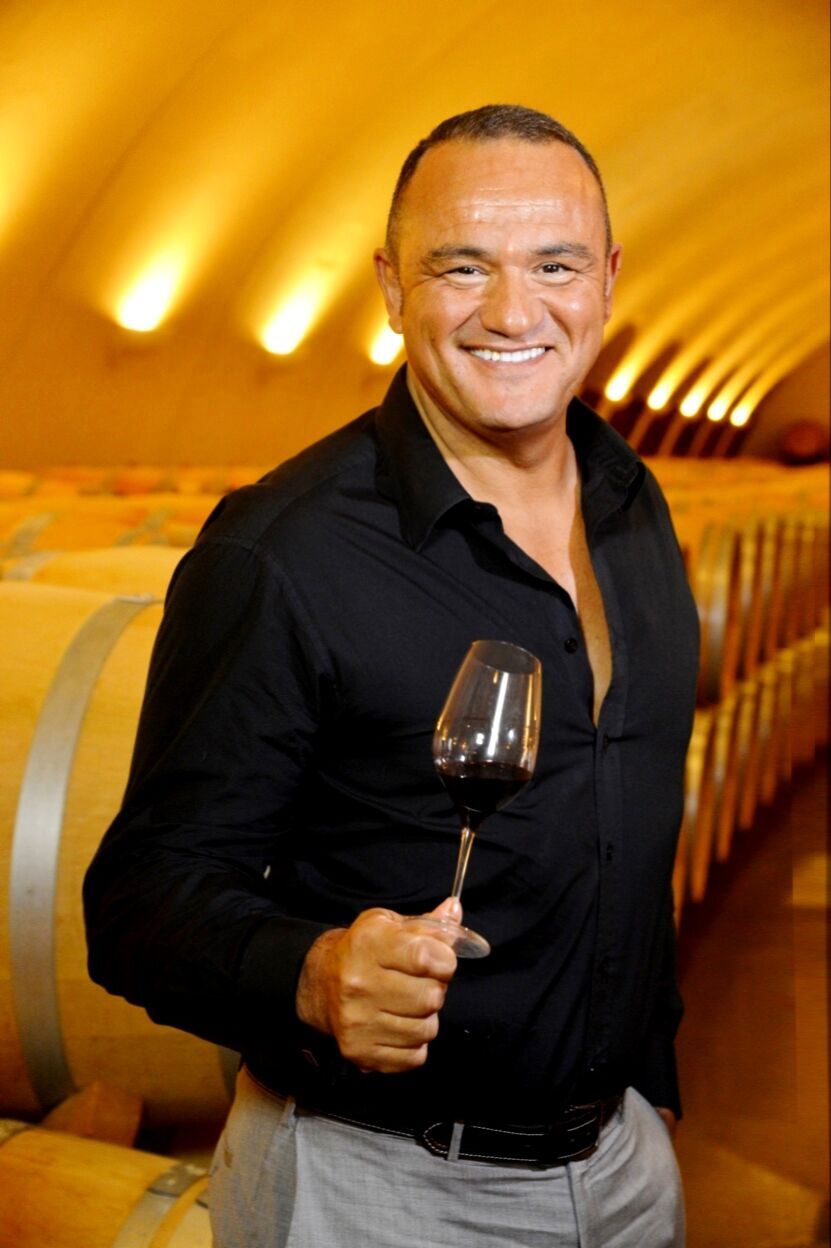 Boudamani (right),
has taken over at Château Lagrézette as
Directeur General and Enologist. A
tall, robust fellow, Boudamani had been
winemaker and VP of Clarence Dillon Wines at the
illustrious First Growth Château Haut Brion,
afterwards joining Francois Lurton—a true
pioneer in Argentina and Chile—as VP of sales.
We recently met over dinner at The Pool in New
York. “The wines of Cahors used to be sold in
bulk in supermarkets,” he said, “but then 70% of
all the wines in France are now sold in
supermarkets.
The image of being a `black wine’ didn’t
help Cahors, and Lagrézette’s vineyard had
itself been pretty much destroyed.”
Boudamani (right),
has taken over at Château Lagrézette as
Directeur General and Enologist. A
tall, robust fellow, Boudamani had been
winemaker and VP of Clarence Dillon Wines at the
illustrious First Growth Château Haut Brion,
afterwards joining Francois Lurton—a true
pioneer in Argentina and Chile—as VP of sales.
We recently met over dinner at The Pool in New
York. “The wines of Cahors used to be sold in
bulk in supermarkets,” he said, “but then 70% of
all the wines in France are now sold in
supermarkets.
The image of being a `black wine’ didn’t
help Cahors, and Lagrézette’s vineyard had
itself been pretty much destroyed.”
The
estate’s modern reincarnation took place when
Alain Dominique Perrin (left with his daughter Julie)
took over the 500-year-old, seven-acre property
in 1980, though he didn’t produce his label
called Le Pigeonnier until 1997. He
planted 83% Malbec, 16% Merlot and 1% Tannat,
then enlarged his holdings in Cahors to include
24 acres in Rocamadour, where he now also grows
Viognier and Syrah, and in 2006 bought 49 more
acres in the Lot River Valley, which he named
after Marguerite de Massaut, who produced the
first wine of Lagrézette back in 1503. Cédric
Blanc is the Château’s winemaker.
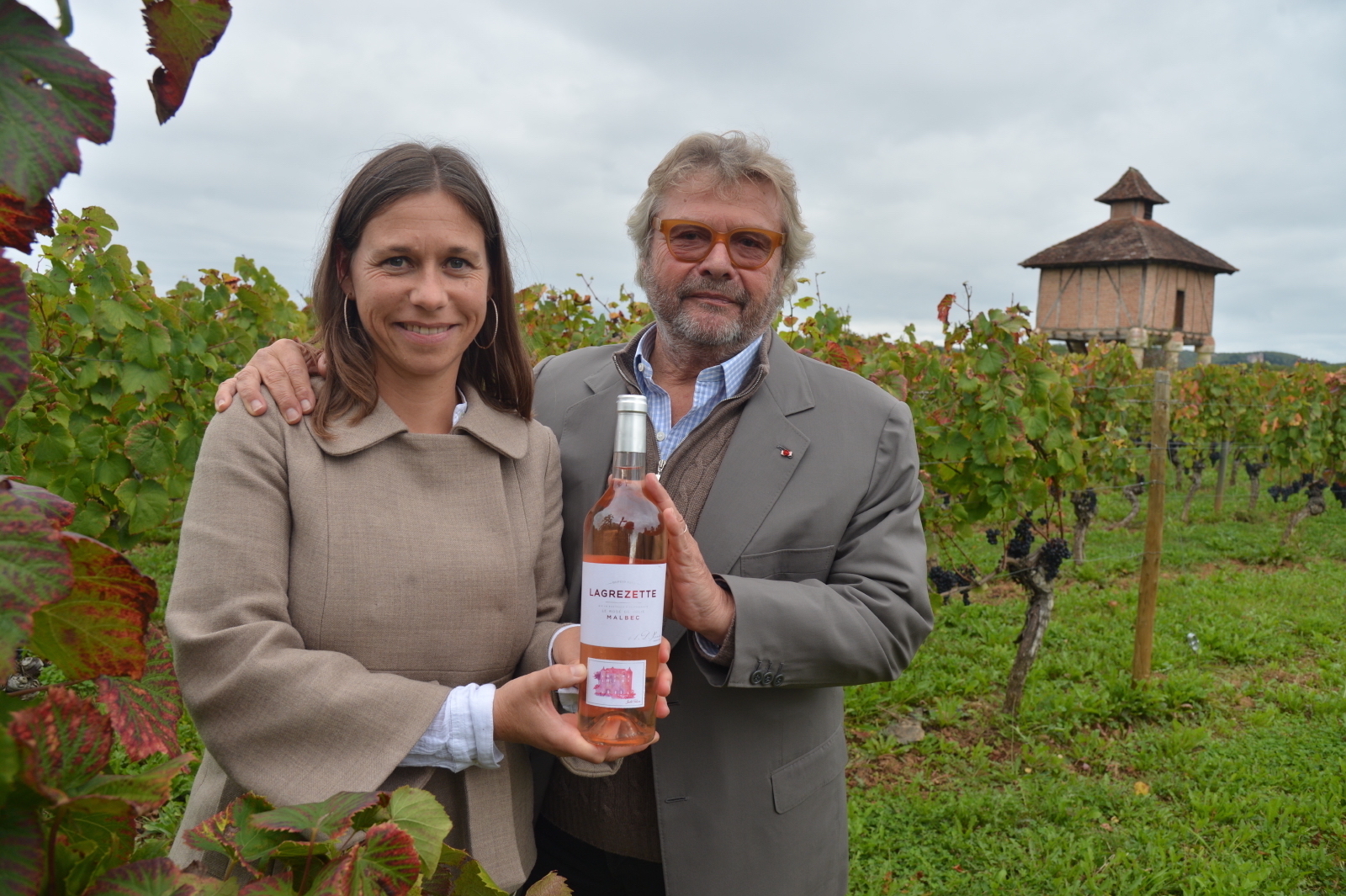 “Malbec
deserves the same attention as any other
varietal in Bordeaux,” said Boudamani. “So we
are meticulous about leaf pruning and harvesting
by hand. We
use no herbicides. We have a prolonged
cold maceration, then the wine is aged in
new French oak from 18 to 28 months.” The new
cellars themselves have been designed to allow
“a non-interventionist vinification process”
through natural gravitational pull, whereby the
grapes are crushed and de-stemmed on the third
floor, sent to stainless steel vats on the
second, and then the wine goes into oat vats to
make the final cuvée.
“Malbec
deserves the same attention as any other
varietal in Bordeaux,” said Boudamani. “So we
are meticulous about leaf pruning and harvesting
by hand. We
use no herbicides. We have a prolonged
cold maceration, then the wine is aged in
new French oak from 18 to 28 months.” The new
cellars themselves have been designed to allow
“a non-interventionist vinification process”
through natural gravitational pull, whereby the
grapes are crushed and de-stemmed on the third
floor, sent to stainless steel vats on the
second, and then the wine goes into oat vats to
make the final cuvée.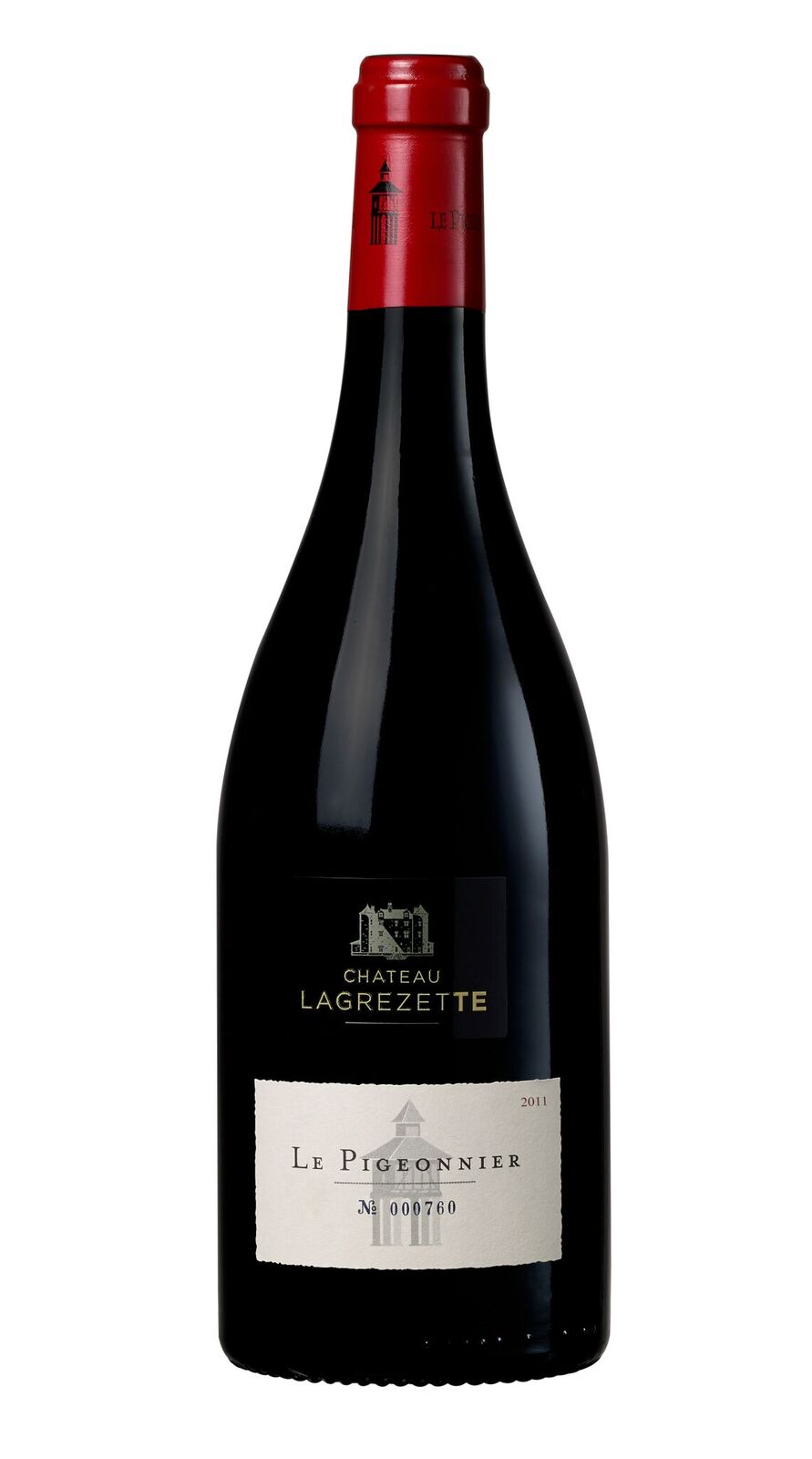
As one who has worked with
Malbec in Argentina, Boudamani said that there
they have the virtue of altitude, so that
individual terroir is not as important as in
Bordeaux or at Lagrézette, where the make-up of
the soil and the micro-climate are critical
aspects of determining what grows best in which
vineyards.
Boudamani
gives enormous credit to Perrin, 75, for
bringing back Cahors’s reputation, saying
“Everybody has followed his lead with Malbec.” Perrin’s
current reputation as an innovative winemaker
was preceded by his re-casting and development
of Cartier International, with a line of “Must
de Cartier” items and by consolidating the
various stores in different parts of the world,
as well as creating the Cartier Foundation for
Contemporary Art in 1984. He
was appointed the President of the Public
Establishment of the Jeu de Paume museum and is
a member of the International Board of London’s
Tate Gallery.
He is not a man who would merely dabble
in wine making. At Lagrézette, Perrin is out to
shake Cahors from its somnolence.
❖❖❖
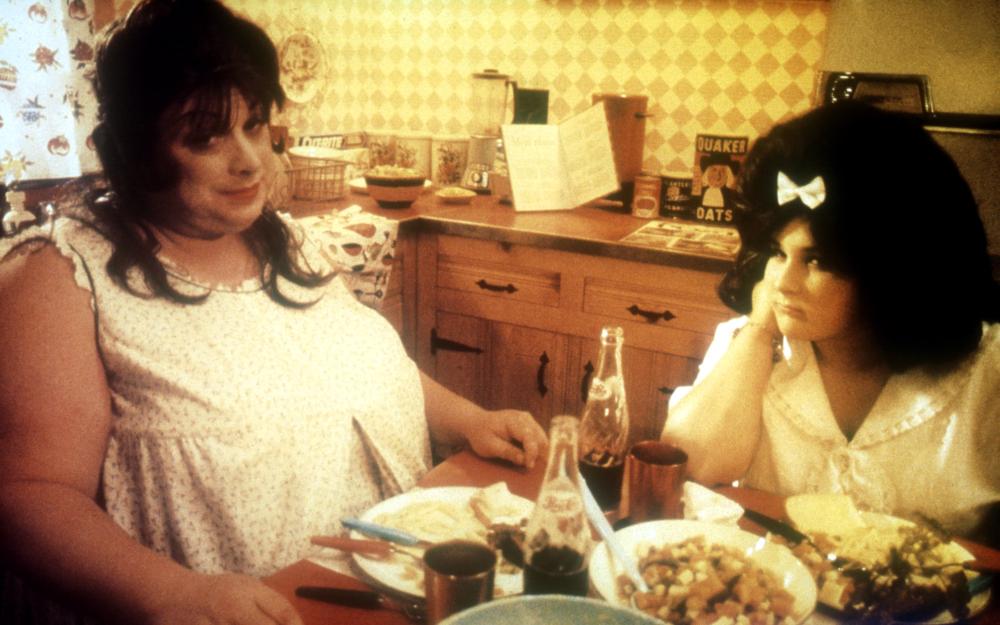 YOU EAT FREE,
MISS DIVINE
YOU EAT FREE,
MISS DIVINE
Trendy
Shrimp restaurant in Hangzhou, Cina, is
giving discounts based on women's breast size--the
larger the breasts, the bigger the discount, as advertised
on a poster placed outside the restaurant that reads, “The whole city is looking for BREASTS,”
with an accompanying image of animated female characters
with varying breast sizes and a table showing how much
of a price cut a woman would get based on her bra size.

"All
across the country, even as the market becomes more
saturated, restaurateurs and titans of industry are
gunning to create the next fast-casual behemoth
— and lately, it seems lots of them have their
sights set on Italian food. Specifically, `Italian
food' that is all-but-guaranteed to appeal to as many
Americans as possible: pasta and pizza.--"Is Italian
Food the Next Frontier of Fast-Casual Eating?"--
Sponsored by Banfi Vintners
SANGIOVESE AUTUMN
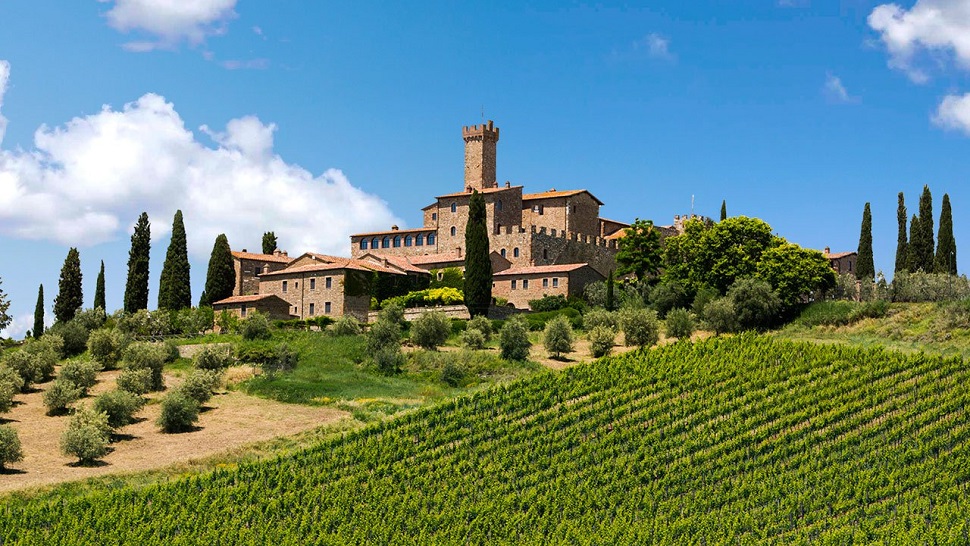 From
mid-September
through mid-October, the Sangiovese grown for our
various styles of red wines are harvested, culminating
with the top selection for Brunello di Montalcino.
Cooler weather means it is time to start enjoying more
red wines and especially Sangiovese based wines. That
includes Banfi’s cru of Brunello, Poggio alle Mura,
literally the cream of the crop of our Sangiovese
vineyards. Alongside our Poggio alle Mura Brunello di
Montalcino, this year we introduced two more wines
from the cru Poggio alle Mura – a Rosso di Montalcino
and a Riserva of Brunello. Rosso is sort of like the
younger brother of Brunello, also made from 100%
Sangiovese grapes but usually a selection from younger
vines and the wine is aged only two years compared to
the four required for Brunello. The
Riserva, on the other hand, is an even more selective
harvest of Sangiovese, and ages for an additional year
before release.
From
mid-September
through mid-October, the Sangiovese grown for our
various styles of red wines are harvested, culminating
with the top selection for Brunello di Montalcino.
Cooler weather means it is time to start enjoying more
red wines and especially Sangiovese based wines. That
includes Banfi’s cru of Brunello, Poggio alle Mura,
literally the cream of the crop of our Sangiovese
vineyards. Alongside our Poggio alle Mura Brunello di
Montalcino, this year we introduced two more wines
from the cru Poggio alle Mura – a Rosso di Montalcino
and a Riserva of Brunello. Rosso is sort of like the
younger brother of Brunello, also made from 100%
Sangiovese grapes but usually a selection from younger
vines and the wine is aged only two years compared to
the four required for Brunello. The
Riserva, on the other hand, is an even more selective
harvest of Sangiovese, and ages for an additional year
before release.
What is so special about this cru
Poggio alle Mura?
Well, it is the result our over 30 years of
ongoing research at my family’s vineyard estate,
Castello Banfi.
When we first began planting our vines there in
the late 1970s studies from the University of Bordeaux
indicated which strains of many varietals we should
plant, based on the soil type and microclimate of each
vineyard. But
when it came to the region’s native Sangiovese, there
was only local lore, no scientific research. So we took
it upon ourselves to figure out this vine, and set off
on three decades of incredibly detailed research.
We started with 600 apparent
variations on Sangiovese, because it is so susceptible
to variations in weather and soil, and narrowed that
down to 160 truly genetically different clones. We planted
a vineyard with two rows of each type, made wine from
each of them, and charted the differences – remember,
you only get one chance a year to make wine, so this
took time.
It
took about ten years to get some concrete results,
though we continue to experiment today and always will
– you never stop learning in science and nature! Once we
determined which were the best, complementary clones
that could be planted together to make the best
Brunello, we chose to plant them in what we determined
to be the optimal vineyard sites. Coincidentally,
the best soils and climate conditions are in the
slopes surrounding the medieval fortress today known
as Castello Banfi, known since Etruscan times as
Poggio alle Mura – the walled hilltop. Hence the
name of our most special “cru” of Brunello,
representing a synthesis between tradition and
innovation.
Though the focus of this study was
our Brunello, all of our Sangiovese-based wines,
including the super Tuscans SummuS, Cum Laude, and
Centine, benefited from this work. And that’s
the third reason for celebrating Sangiovese this
month, for the range of wonderful reds that usher us
into autumn! One
wine in particular was inspired by our research – the
BelnerO, a Sangiovese dominant blend with what I like
to call a kiss of Cabernet and a whisper of Merlot. We grow the
grapes a little differently for BelnerO than for
Brunello, make the wine with less oak aging and
released it earlier from the winery, providing a
counterpoint to Brunello and a lovely terroir-driven
wine in its own right.
If you know Italians, you know that by nature
we are multi-faceted, varying in mood, and always
passionate. As
a nation, we span from the hot sunny beaches of Sicily
near the African coast to the rugged mountains and
Alpine ski slopes of Trentino-Alto Adige in the north. Sangiovese
is grown in almost all of Italy’s regions and reflects
the unique nature of each; it is most famous
(rightfully so) in Tuscany, yet even there it reflects
the nuances of each hilltop, valley and subzone. It has
something a little different to say in Brunello than
Chianti, Morellino than Vino Nobile di Montepulciano,
Rosso di Montalcino than Super Tuscan blends.
Here
is a smattering of Sangiovese-based wines that you may
wish to get to know better, reflecting a spectrum that
appeals to every occasion, every taste, and every
budget. We
can assure you that the conversation will never become
boring.
Recommendations for Celebrating
Sangiovese
BelnerO Proprietor’s Reserve Sangiovese
– A refined cuvée of noble red grapes
perfected by our pioneering clonal research. This dark
beauty, BelnerO, is produced at our innovative winery,
chosen 11 consecutive years as Italy’s Premier
Vineyard Estate. Fermented in our patented temperature
controlled French oak and aged approximately 2
additional years. Unfiltered, and Nitrogen bottled to
minimize sulfites.
Castello Banfi Brunello di Montalcino –
Rich, round, velvety and intensely
aromatic, with flavor hints of licorice, cherry, and
spices. Brunello di Montalcino possesses an intense
ruby-red color, and a depth, complexity and opulence
that is softened by an elegant, lingering aftertaste.
Unfiltered after 1998 vintage.
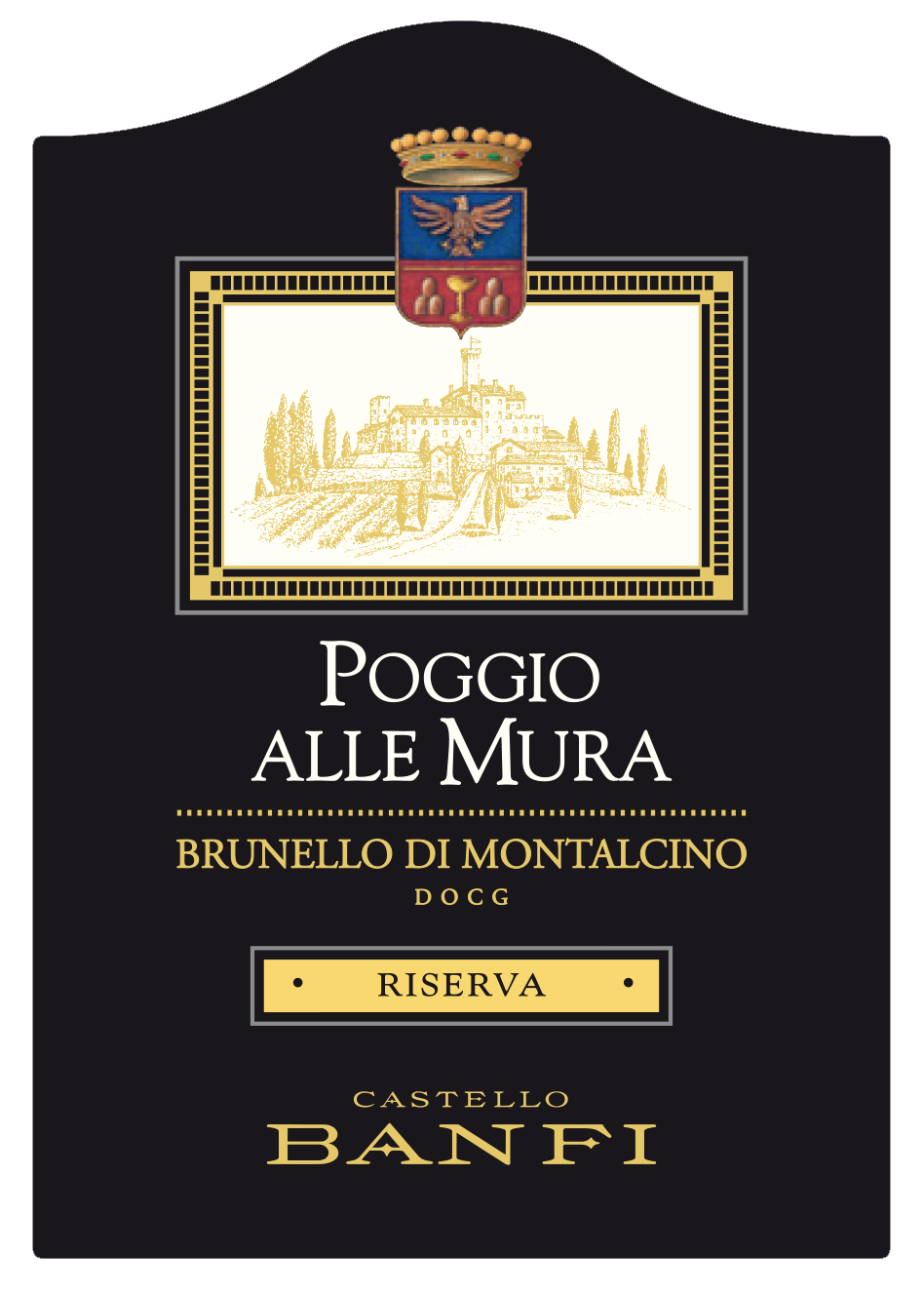 Castello Banfi Rosso di
Montalcino – Brunello's "younger brother," produced
from select Sangiovese grapes and aged in barrique for
10 to 12 months. Deep ruby-red, elegant, vibrant,
well-balanced and stylish with a dry velvety
finish.
Castello Banfi Rosso di
Montalcino – Brunello's "younger brother," produced
from select Sangiovese grapes and aged in barrique for
10 to 12 months. Deep ruby-red, elegant, vibrant,
well-balanced and stylish with a dry velvety
finish.
Poggio all’Oro Brunello di Montalcino
Riserva – A single vineyard selection of our most
historically outstanding Sangiovese, aged five years
before release, the additional year more than that
required of Brunello including 6 months in barrel and
6 months more in bottle to grant its “Riserva”
designation. Incredible
elegance and harmony. Intense with lots of fruit and
subtle wood influence. Round, complete, well balanced
with hints of chocolate and berries. Unfiltered after
1998.
Poggio alle Mura – The first tangible result of years of
intensive clonal research on Montalcino’s native
Sangiovese grape.
Estate bottled from the splendidly sun drenched
vineyards surrounding the medieval Castello from which
it takes its name.
The Brunello
di Montalcino is seductive, silky and smoky. Deep ruby
in color with an expressive bouquet of violets, fruits
and berries as well as cigar box, cedar and exotic
spices.
The Rosso di
Montalcino is also intense ruby red. The bouquet
is fresh and fruity with typical varietal notes of
cherry and blackberry, enriched by more complex hints
of licorice, tobacco and hazelnut. It is full
bodied, yet with a soft structure, and a surprisingly
long finish. The
Poggio
alle Mura Brunello di Montalcino Riserva is
deep ruby red with garnet reflections and a rich,
ample bouquet that hints of prune jam, coffee, cacao
and a light balsamic note. It is full and powerful, with
ripe and gentle tannins that make it velvety and
harmonious; this wine is supported by a pleasing
minerality that to me speaks soundly of that special
hillside in southern Montalcino.
SummuS – A wine of towering elegance, SummuS is an
extraordinary blend of Sangiovese which contributes
body; Cabernet Sauvignon 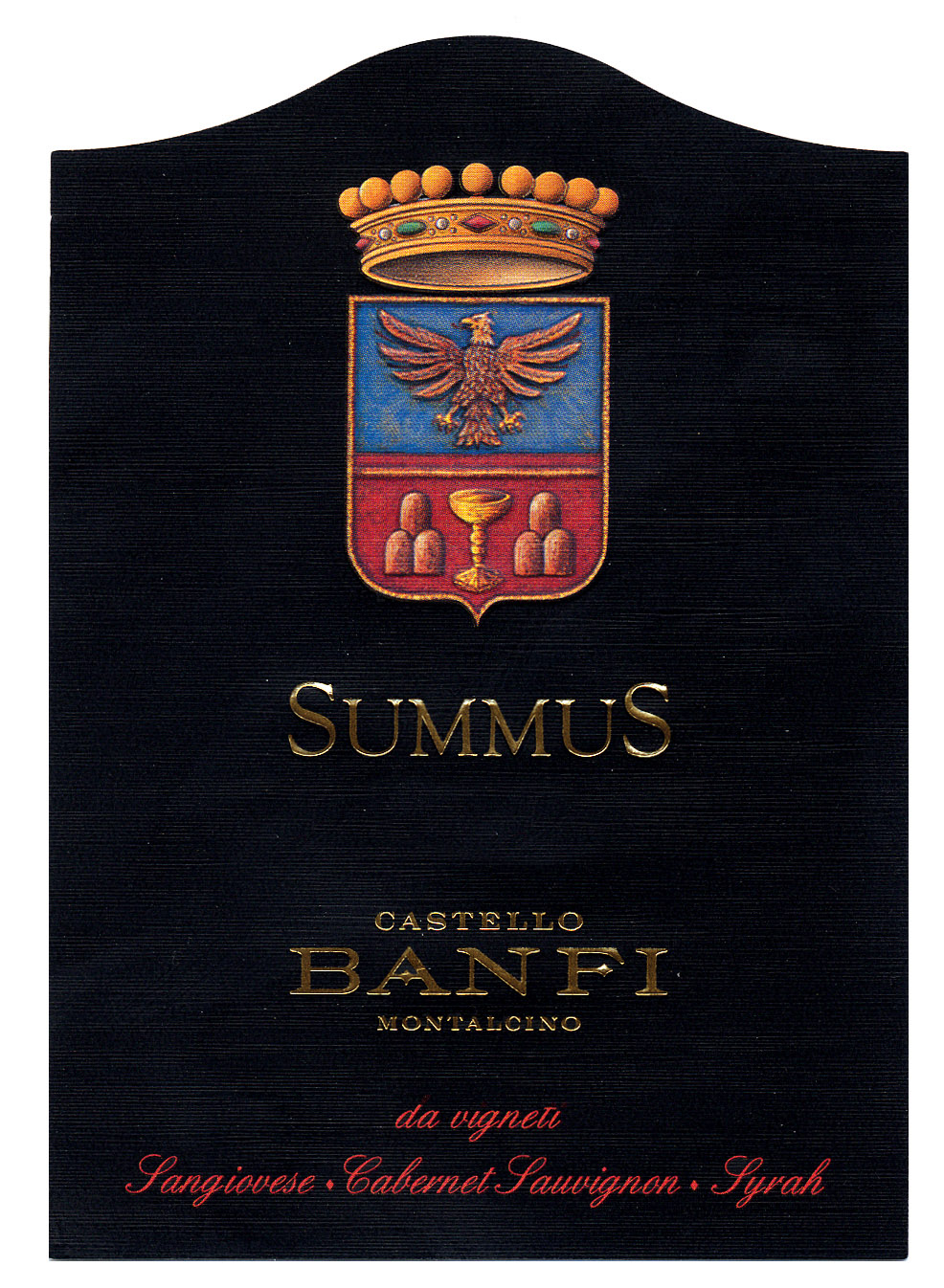 for fruit and
structure; and Syrah for elegance, character and a
fruity bouquet.
An elegant, complex and harmonious red
wine.
for fruit and
structure; and Syrah for elegance, character and a
fruity bouquet.
An elegant, complex and harmonious red
wine.
Cum Laude – A complex and elegant red which graduated
“With Honors,” characterized by aromas of juicy
berries and fresh spices.
Centine – A Cuvee that is more than half
Sangiovese, the balanced consisting of equal parts of
Cabernet Sauvignon and Merlot. Vinified in
a firm, round style that easily accompanies a wide
range of dishes, this is a smooth and fragrantly
satisfying wine with international character, and a
perennial favorite at my own dinner table.
 Banfi Chianti
Superiore – The “Superiore” designation signifies
stricter government regulations regarding production
and aging requirements, as compared to regular
Chianti. An
intense ruby red wine with fruit forward aromas and
floral notes. This
is a round wine with well-balanced acidity and fruit.
Banfi Chianti
Superiore – The “Superiore” designation signifies
stricter government regulations regarding production
and aging requirements, as compared to regular
Chianti. An
intense ruby red wine with fruit forward aromas and
floral notes. This
is a round wine with well-balanced acidity and fruit.
Banfi Chianti Classico – An enduring classic: alluring
bouquet of black fruit and violets; rich flavors of
cherry and leather; supple tannins and good acidity
for dining.
Banfi Chianti Classico Riserva – Produced from select grapes grown in the
"Classico" region of Chianti, this dry, fruity and
well-balanced red has a full bouquet reminiscent of
violets.
Fonte alla Selva Chianti Classico – This is our newest entry into the Chianti
arena, coming from a 99 acre estate in Castellina, the
heart of the Chianti Classico region. The wine is
a captivating mauve red that smells of cherry, plum
and blackberry with hints of spice. It is
round, full and balanced with very good
acidity.
Col di Sasso – Sangiovese and Cabernet Sauvignon. Luscious,
complex and soft with persistent notes of fruit and
great Italian style structure.
❖❖❖
Any of John Mariani's books below may be ordered from amazon.com.
 The
Hound in Heaven (21st Century Lion Books)
is a novella, and for anyone who loves dogs,
Christmas, romance, inspiration, even the supernatural, I
hope you'll find this to be a treasured favorite.
The story concerns how, after a New England teacher,
his wife and their two daughters adopt a stray puppy found
in their barn in northern Maine, their lives seem full of
promise. But when tragedy strikes, their wonderful dog
Lazarus and the spirit of Christmas are the only things
that may bring his master back from the edge of
despair.
The
Hound in Heaven (21st Century Lion Books)
is a novella, and for anyone who loves dogs,
Christmas, romance, inspiration, even the supernatural, I
hope you'll find this to be a treasured favorite.
The story concerns how, after a New England teacher,
his wife and their two daughters adopt a stray puppy found
in their barn in northern Maine, their lives seem full of
promise. But when tragedy strikes, their wonderful dog
Lazarus and the spirit of Christmas are the only things
that may bring his master back from the edge of
despair. WATCH THE VIDEO!
“What a huge surprise turn this story took! I was completely stunned! I truly enjoyed this book and its message.” – Actress Ali MacGraw
“He had me at Page One. The amount of heart, human insight, soul searching, and deft literary strength that John Mariani pours into this airtight novella is vertigo-inducing. Perhaps ‘wow’ would be the best comment.” – James Dalessandro, author of Bohemian Heart and 1906.
“John Mariani’s Hound in Heaven starts with a well-painted portrayal of an American family, along with the requisite dog. A surprise event flips the action of the novel and captures us for a voyage leading to a hopeful and heart-warming message. A page turning, one sitting read, it’s the perfect antidote for the winter and promotion of holiday celebration.” – Ann Pearlman, author of The Christmas Cookie Club and A Gift for my Sister.
“John Mariani’s concise, achingly beautiful novella pulls a literary rabbit out of a hat – a mash-up of the cosmic and the intimate, the tragic and the heart-warming – a Christmas tale for all ages, and all faiths. Read it to your children, read it to yourself… but read it. Early and often. Highly recommended.” – Jay Bonansinga, New York Times bestselling author of Pinkerton’s War, The Sinking of The Eastland, and The Walking Dead: The Road To Woodbury.
“Amazing things happen when you open your heart to an animal. The Hound in Heaven delivers a powerful story of healing that is forged in the spiritual relationship between a man and his best friend. The book brings a message of hope that can enrich our images of family, love, and loss.” – Dr. Barbara Royal, author of The Royal Treatment.
 |
The Encyclopedia of American Food and Drink by John F. Mariani (Bloomsbury USA, $35) Modesty forbids me to praise my own new book, but let me proudly say that it is an extensive revision of the 4th edition that appeared more than a decade ago, before locavores, molecular cuisine, modernist cuisine, the Food Network and so much more, now included. Word origins have been completely updated, as have per capita consumption and production stats. Most important, for the first time since publication in the 1980s, the book includes more than 100 biographies of Americans who have changed the way we cook, eat and drink -- from Fannie Farmer and Julia Child to Robert Mondavi and Thomas Keller. "This book is amazing! It has entries for everything from `abalone' to `zwieback,' plus more than 500 recipes for classic American dishes and drinks."--Devra First, The Boston Globe. "Much needed in any kitchen library."--Bon Appetit. |
"Eating Italian will never be the same after reading John Mariani's entertaining and savory gastronomical history of the cuisine of Italy and how it won over appetites worldwide. . . . This book is such a tasteful narrative that it will literally make you hungry for Italian food and arouse your appetite for gastronomical history."--Don Oldenburg, USA Today. "Italian
restaurants--some good, some glitzy--far
outnumber their French rivals. Many of
these establishments are zestfully described
in How Italian Food Conquered the World, an
entertaining and fact-filled chronicle by
food-and-wine correspondent John F.
Mariani."--Aram Bakshian Jr., Wall Street
Journal.
"Equal parts
history, sociology, gastronomy, and just
plain fun, How Italian Food Conquered the
World tells the captivating and delicious
story of the (let's face it) everybody's
favorite cuisine with clarity, verve and
more than one surprise."--Colman Andrews,
editorial director of The Daily
Meal.com. "A fantastic and fascinating
read, covering everything from the influence
of Venice's spice trade to the impact of
Italian immigrants in America and the
evolution of alta cucina. This book will
serve as a terrific resource to anyone
interested in the real story of Italian
food."--Mary Ann Esposito, host of PBS-TV's
Ciao
Italia. "John Mariani has written the
definitive history of how Italians won their
way into our hearts, minds, and
stomachs. It's a story of pleasure over
pomp and taste over technique."--Danny Meyer,
owner of NYC restaurants Union Square
Cafe, The Modern, and Maialino.
|
 |
 |
 |
 |
 |
 |
 |
 |
 Everett Potter's Travel Report:
Everett Potter's Travel Report: 
 Eating Las Vegas
JOHN CURTAS has been covering the Las Vegas
food and restaurant scene since 1995. He is
the co-author of EATING LAS VEGAS – The 50
Essential Restaurants (as well as
the author of the Eating Las Vegas web site: www.eatinglasvegas.
He can also be seen every Friday morning as
the “resident foodie” for Wake Up With the
Wagners on KSNV TV (NBC) Channel 3 in
Las Vegas.
Eating Las Vegas
JOHN CURTAS has been covering the Las Vegas
food and restaurant scene since 1995. He is
the co-author of EATING LAS VEGAS – The 50
Essential Restaurants (as well as
the author of the Eating Las Vegas web site: www.eatinglasvegas.
He can also be seen every Friday morning as
the “resident foodie” for Wake Up With the
Wagners on KSNV TV (NBC) Channel 3 in
Las Vegas.

MARIANI'S VIRTUAL GOURMET
NEWSLETTER is published weekly. Editor/Publisher: John
Mariani.
Editor: Walter Bagley. Contributing Writers: Christopher Mariani,
Robert Mariani, Misha Mariani, John A. Curtas, Geoff Kalish, Mort
Hochstein, and
Brian Freedman. Contributing Photographer: Galina
Dargery. Technical Advisor: Gerry McLoughlin.
To un-subscribe from this newsletter,click here.
© copyright John Mariani 2017

